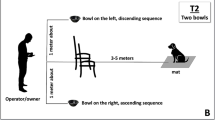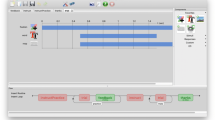Abstract
Modern theories of learned vocal behaviours, such as human speech and singing in songbirds1, posit that acoustic communication signals are reproduced from memory, using auditory feedback2. The nature of these memories, however, is unclear. Here we propose and test a model for how complex song structure can emerge from sparse sequence information acquired during tutoring. In this conceptual model, a population of combination-sensitive (phrase-pair) detectors is shaped by early exposure to song and serves as the minimal representation of the template necessary for generating complete song. As predicted by the model, birds that were tutored with only pairs of normally adjacent song phrases were able to assemble full songs in which phrases were placed in the correct order; birds that were tutored with reverse-ordered phrase pairs sang songs with reversed phrase order. Birds that were tutored with all song phrases, but presented singly, failed to produce normal, full songs. These findings provide the first evidence for a minimal requirement of sequence information in the acoustic model that can give rise to correct song structure.





Similar content being viewed by others
References
Doupe, A. J. & Kuhl, P. K. Birdsong and human speech: Common themes and mechanisms. Annu. Rev. Neurosci. 22, 567–631 (1999)
Konishi, M. The role of auditory feedback in the control of vocalization in the white-crowned sparrow. Z. Tierpsychol. 22, 770–783 (1965)
Thorpe, W. H. Birdsong (Cambridge Univ. Press, London, 1961)
Konishi, M. Perception and Experience (Plenum, New York, 1978)
Hultsch, H. & Todt, D. Discontinuous and incremental processes in the song learning of birds: Evidence for the primer effect. J. Comp. Physiol. 179, 291–299 (1996)
Marler, P. & Peters, S. Sparrows learn adult song and more from memory. Science 213, 780–782 (1981)
Soha, J. A. & Marler, P. Vocal syntax development in the white-crowned sparrow (Zonotrichia leucophrys). J. Comp. Psychol. 115, 172–180 (2001)
Marler, P. & Tamura, M. Song ‘dialects’ in three populations of white-crowned sparrows. Condor 64, 363–399 (1962)
Marler, P. & Tamura, M. Culturally transmitted patterns of vocal behavior in sparrows. Science 146, 1483–1486 (1964)
Marler, P. A comparative approach to vocal learning: Song development in white-crowned sparrows. J. Comp. Physiol. Psychol. 71, 1–25 (1970)
Tchernichovski, O., Mitra, P. P., Lints, T. & Nottebohm, F. Dynamics of the vocal imitation process: How a zebra finch learns its song. Science 291, 2564–2569 (2001)
Margoliash, D. Acoustic parameters underlying the responses of song-specific neurons in the white-crowned sparrow. J. Neurosci. 3, 1039–1057 (1983)
Margoliash, D. & Fortune, E. S. Temporal and harmonic combination sensitive neurons in the zebra finch's HVc. J. Neurosci. 12, 4309–4326 (1992)
Lewicki, M. S. & Arthur, B. J. Hierarchical organization of auditory temporal context sensitivity. J. Neurosci. 16, 6987–6998 (1996)
Lewicki, M. S. & Konishi, M. Mechanisms underlying the sensitivity of songbird forebrain neurons to temporal order. Proc. Natl Acad. Sci. USA 92, 5582–5586 (1995)
Lewicki, M. S. Intracellular characterization of song-specfic neurons in the zebra finch auditory forebrain. J. Neurosci. 16, 5854–5863 (1996)
Mooney, R. Different subthreshold mechanisms underlie song selectivity in identified HVc neurons of the zebra finch. J. Neurosci. 20, 5420–5436 (2000)
Doupe, A. Song- and order-selective neurons in the songbird anterior forebrain and their emergence during vocal development. J. Neurosci. 17, 1147–1167 (1997)
Volman, S. F. Development of neural selectivity for birdsong during vocal learning. J. Neurosci. 13, 4737–4747 (1993)
Solis, M. M. & Doupe, A. Anterior forebrain neurons develop selectivity by an intermediate stage of song learning. J. Neurosci. 17, 6447–6462 (1997)
Bottjer, S. W., Miesner, E. A. & Arnold, A. P. Forebrain lesions disrupt development but not maintenance of song in passerine birds. Science 224, 901–903 (1984)
Aldridge, J. W. & Berridge, K. C. Coding of serial order by neostriatal neurons: a “natural action” approach to movement sequence. J. Neurosci. 7, 2777–2787 (1998)
Klein, D., Zatorre, R. J., Milner, B., Meyer, E. & Evans, A. C. Left putaminal activation when speaking a second language: evidence from PET. Neuroreport 5, 2295–2297 (1994)
Griffiths, R., Double, M. C., Orr, K. & Dawson, R. J. G. A DNA test to sex most birds. Mol. Ecol. 7, 1071–1075 (1998)
Acknowledgements
This work was supported by grants from the University of Utah and NIH. We thank T. Dance for technical assistance, E. Haskell for guidance in statistical analyses, J. Whittington for molecular sexing of birds and R. Dendukuri for writing computer programs used in analysis and presentation of data.
Author information
Authors and Affiliations
Corresponding author
Ethics declarations
Competing interests
The authors declare that they have no competing financial interests.
Supplementary information
Supplementary Figure, Legend and Text
A detailed description of the model proposed and tested in our experiment whereby birds tutored with phrase pairs are able to assemble complete songs. The figure represents a graphical depiction of the model for a song consisting of three phrases. (DOC 139 kb)
Rights and permissions
About this article
Cite this article
Rose, G., Goller, F., Gritton, H. et al. Species-typical songs in white-crowned sparrows tutored with only phrase pairs. Nature 432, 753–758 (2004). https://doi.org/10.1038/nature02992
Received:
Accepted:
Issue Date:
DOI: https://doi.org/10.1038/nature02992
- Springer Nature Limited
This article is cited by
-
Overlooked evidence for semantic compositionality and signal reduction in wild chimpanzees (Pan troglodytes)
Animal Cognition (2022)
-
Statistical learning for vocal sequence acquisition in a songbird
Scientific Reports (2020)
-
A neuronal signature of accurate imitative learning in wild-caught songbirds (swamp sparrows, Melospiza georgiana)
Scientific Reports (2017)
-
Songbirds work around computational complexity by learning song vocabulary independently of sequence
Nature Communications (2017)
-
Human melody singing by bullfinches (Pyrrhula pyrrula) gives hints about a cognitive note sequence processing
Animal Cognition (2014)





